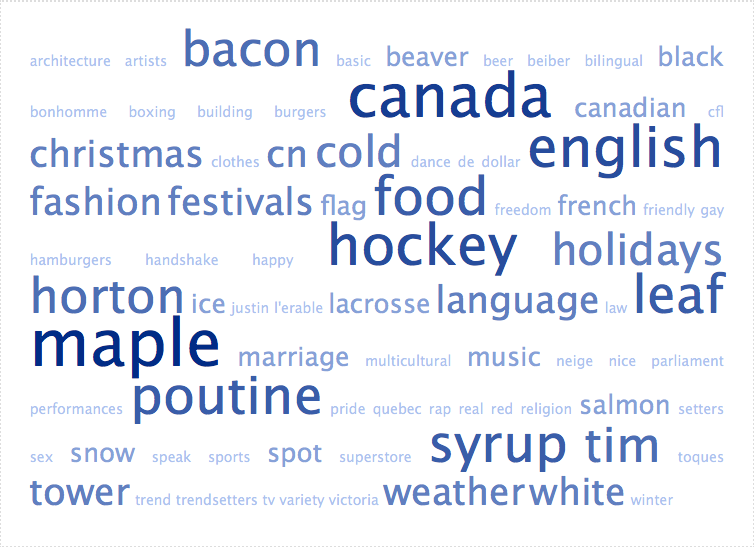I’ve been working with my collaboration partner, preparing a presentation we will give at an upcoming conference. The focus of the presentation is the ways in which we integrate culture in our lessons. We’ve worked really hard to get away from viewing the integration of culture as (a) a checklist, or (b) simplistic. We have agreed that showing pictures of the Eiffel Tower in a French class isn’t what we mean by “integrating culture”. Eating crêpes – also not culture. The words to our national anthem in French, looking at information about festivals, listening to music, travel brochures… all of these things can be adapted to include the integration of culture, but they don’t do it in and of themselves.
So what is it?
Our curriculum document includes some information about culture, and what we are supposed to do with it in our French classes. For example, I’ve highlighted areas that specifically talk about culture in French 8:

Two of the Big Ideas reference culture, and when you add it up visually, about a third of the curriculum has at least some connection to culture. The elaborations on the content give further details on what “cultural aspects” means: “for example, activities, celebrations, clothing, dance, festivals, First Peoples regalia, food, history, land, music, protocol, rituals, traditions.” (Source: BC Revised Curriculum 2018). The document tells us that “students are expected to know the following”. But what does it really mean to “know” cultural aspects? Should they be able to name them? Pick them out in a photo? Say their names in the target language? Here’s where things started to get really interesting in our collaboration.
Teaching a course in BC also means integrating the Core Competencies. The competency that most closely connects to culture is Positive Personal and Cultural Identity. The introduction to this section of the core competencies says the following about what awareness students need to develop around personal and cultural identity : “The positive personal and cultural identity competency involves the awareness, understanding, and appreciation of all the facets that contribute to a healthy sense of oneself. It includes awareness and understanding of one’s family background, heritage(s), language(s), beliefs, and perspectives in a pluralistic society.” Knowing that this is the awareness our students are expected to develop indicates that we need to be going much deeper than just the surface aspects of culture.
The other area that closely connects to culture is the First Peoples Principles of Learning. The first Principle of Learning states that “learning ultimately supports the well-being of the self, the family, the community, the land, the spirits, and the ancestors.” (Source )
Learning ultimately supports the well-being of the self, the family, the community, the land, the spirits, and the ancestors.
When we connect the curriculum mandate to incorporate culture with the core competency of developing a positive personal and cultural identity and the First Peoples Principles of Learning, the direction we need to go in is clear. Scratching the surface of culture isn’t enough. In order to help students develop a knowledge of their own culture, they need to understand others. On a deep level.

The aspects of culture that we see above the water are those we would see as tourists in a place we are visiting. Those aspects below the water line are the really interesting ones, the areas where culture is deeply determined. In order to find these, we have to be intentional about looking for them. They are often buried and implied, revealed through biases and suggestions, but can be incredibly interesting.
Here’s the problem – most (all?) of the cultural content in language classes deals with the stuff above the water line. We have to get below the water if we’re going to achieve real understanding.
My current French 11 class has gone through their years of education largely without the core competencies in place, and I was curious to see what they knew about their own culture, as well as that of Francophone areas. I gave them a self reflection exercise to see what they were able to tell me, and the graphic below shows the key words they used to describe the “above the water” elements of Canadian culture.

Phrases like “Justin Beiber”, “Tim Horton’s”, “maple leaf”, “maple syrup” and “CN Tower” were separated in this graphic, so they appear as separate words but weren’t written that way on the reflections. This reads much like a collection of stereotypes about Canada, but perhaps the most striking thing is that although these students completed this reflection in a FRENCH as a second language class and the participants came from a wide range of cultural backgrounds, they almost universally thought that Canadians only speak English.
There are huge opportunities here for cultural exploration and development of self and identity. I see this picture as a bit of a self assessment for me, even though most of these students have not been in my class before. Most of us work with similar resources, but this really highlights for me the importance of working hard to adapt those resources to allow for more cultural comparison and integration. Second language classes are a perfect place to start that exploration. I’m working on more assignments that will ask my students to do just that, and will follow up at the end with another “iceberg” reflection to see where their understanding is at the end of the course. My growth mentality as a teacher is equally important to that of my students.

